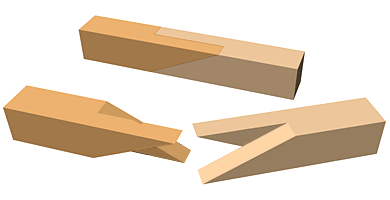A halved rabbeted (oblique) scarf joint *sogitsugi
殺継. A simple scarf joint, often called a crossbill scarf because it resembles
the open bill of a bird. The so-called 'female end' is spliced obliquely with
half the width of the timber cut off from the top and the other half cut off on
the underside. The 'male piece' is cut into exactly the same shape except that
the oblique surfaces are reversed to allow them to fit together perfectly. Because
this is a rather weak joint, a key *shachi
車知, is inserted into the double-faced joint a little over half the thickness of
the timber. It does not reach through the lower face. Stub tenons are cut in proportion
to the width of the joint. Called the sumikiri isukatsugi 隅切いすか継, it is
used in buildings like monks' dormitories where appearance is unimportant. Also
used to join the ribs *goubuchi
格縁, of a coffered ceiling, *goutenjou
格天井. More complex scarf joints include the one called the miyajimatsugi
宮島継 which is a triple-faced, halved, rabbeted, oblique scarf joint with a key.
It differs from ordinary triple spiced scarf joints in that it has a triple-faced
cone shape at the end of the obliquely cut surfaces. One type of halved rabbeted
oblique scarf joint has four faces. It looks simple but is very difficult to make.
Isukatsugi joint and all its variations are made in the direction of the
grain. Examples: Okadera 岡寺 (1612) in Nara, used on the eave purlin *dashigeta
出桁 of the gate, Nioumon 仁王門; Itsukushima Jinja Ootorii 厳島神社大鳥居 (1875), in Miyajima 宮島,
Hiroshima prefecture. The miyajimatsugi is used on this gate, from
which it derives its name.
|


